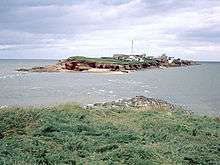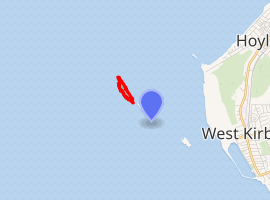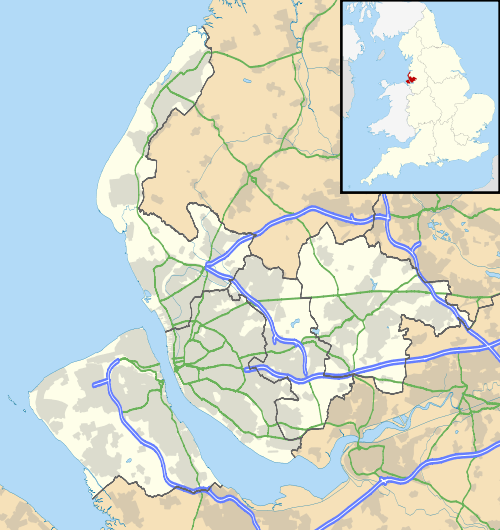Hilbre Islands
The Hilbre Islands (/ˈhɪlbriː/ HIL-bree) are an archipelago consisting of three islands at the mouth of the estuary of the River Dee, the border between England and Wales at this point. The islands are administratively part of the Metropolitan Borough of Wirral. They are a Local Nature Reserve and are within the estuary Site of Special Scientific Interest.[1][2] As of 2012, the islands have no permanent residents. The name is thought to derive from a chapel built on the Island and dedicated to St. Hildeburgh. During the summer months tourists travel by foot to the Islands from West Kirby.
| Hilbre Islands | |
|---|---|
 Hilbre Island from Middle Eye | |

| |
| Type | Common |
| Location | West Kirby, Merseyside |
| Coordinates | 53.38°N 3.22°W |
| Operated by | Metropolitan Borough of Wirral |
| Open | All year, dependent on tide |
| Status | Open |

Origin of the name
Hilbre Island's name derives from the dedication of a medieval chapel built on the island to St. Hildeburgh, an Anglo-Saxon holy woman, after which it became known as Hildeburgheye or Hildeburgh's island.[3] Hildeburgh is said to have lived on Hilbre Island in the 7th century as an anchorite. Some consider that she never existed, while others equate her with Saint Ermenhilde, the mother of Saint Werburgh to whom Chester Cathedral is dedicated,[4] or St Edburga of Mercia, daughter of the pagan king Penda.[5] The 19th-century St Hildeburgh's Church, Hoylake, built nearby on the mainland, is named for her.
History
The islands are thought to have been occupied on and off since the Stone Age: several finds of Stone and Bronze Age items and Roman pottery items were discovered in 1926.
Hilbre Island may already have been a hermitage before the Norman invasion[6] or at least a place of pilgrimage[7] based around the lore of St Hildeburgh. In about 1080 a cell and church for Benedictine monks was established on Hilbre Island as a dependency of Chester Cathedral. Although not named directly, it is believed that all three islands were mentioned in the Domesday Book in which mention is made of Chircheb (West Kirby) having two churches: one in the town and one on an island in the sea.
The islands were part of the lands of the Norman lord Robert of Rhuddlan. He gave the islands to the abbey at Saint-Evroul-sur-Ouche in Normandy, who in turn passed responsibility to the Abbey of St. Werburgh in Chester.[3] The islands became a common place for pilgrimage in the 13th and 14th centuries. At the dissolution of the monasteries two monks were allowed to remain on the islands, as they maintained a beacon for shipping in the river mouth. The last monk left the islands in about 1550,[5] as they was no longer considered a sanctuary, having become a centre for commerce and a busy trading port – so much so that a custom house was established to collect taxes on the goods traded. John Leland briefly describes Hilbre Island in his Itineraries (c. 1538–43) and says that "there was a Celle of Monkes of Chestre and a Pilgrimage of Our Lady of Hilbyri", though his contemporary description mentions only "conies" (rabbits) inhabiting the island.[8] William Camden wrote of Hilbre in Britannia (1586), the first chorographical survey of the islands of Great Britain and Ireland, as follows: "In the utmost brinke of this Promontorie lieth a small, hungrie, barren and sandie Isle called Il-bre, which had sometime a little cell of monkes in it."[9]
In 1692 a small factory was set up to refine rock salt. There was also a beer house or inn, which was open when the writer Richard Ayton visited in 1813.[10] With the silting of the River Dee trade switched to ports on the River Mersey and the trade vanished from the islands leading to the closure of the beer house; part of the structure of this building remains incorporated in the custodian's residence.
The islands were bought in 1856 by the Trustees of the Liverpool Docks, which later became known as the Mersey Docks and Harbour Board. Hilbre Island Lighthouse was constructed here in 1927. The islands were sold to Hoylake Council in 1945 for £2,500, passing to Wirral Borough Council on its formation in 1974.
Location and character
Hilbre Island, the largest of the group, is approximately 11.5 acres (47,000 m2; 4.7 ha) in area, and lies about 1 mile (1.6 km) from Red Rocks, the nearest part of the mainland of the Wirral Peninsula. The other two islands are Middle Eye (or in older sources Middle Island and on Ordnance Survey maps Little Hilbre), which is about 3 acres (12,000 m2; 1.2 ha) in size and Little Eye, which is considerably smaller. All three islands are formed of red Bunter sandstone. The main island and Middle Eye are less than a hundred yards apart.
Tourism
Hilbre Island is one of 43 (unbridged) tidal islands that can be reached on foot from the mainland of Great Britain.[11] The island can be reached on foot from West Kirby at low tide; this is a popular activity with tourists, especially during the summer months. Little Eye and Middle Eye are both unpopulated, but Hilbre Island has a few houses, some of which are privately owned.
Facilities
The most southerly building on the islands is the Hilbre Bird Observatory, from which birds are continuously monitored in connection with a national network of observatories and ringing stations.[11] In January 2011 it was announced that there would be no permanent ranger. Wirral Council said that they had had difficulty finding a ranger prepared to live without mains electricity or running water on the islands.[12] There are two composting toilets and a rain shelter on the main island.
Gallery
.jpg) The old telegraph station
The old telegraph station.jpg) A wind turbine and houses
A wind turbine and houses.jpg) Wooden buildings, looking towards West Kirby
Wooden buildings, looking towards West Kirby The old lifeboat station
The old lifeboat station Middle Eye
Middle Eye Little Eye
Little Eye
See also
References
- "Hilbre Island". Local Nature Reserves. Natural England. Archived from the original on 14 December 2013.
- "Map of Hilbre Island". Local Nature Reserves. Natural England.
- Roberts, Stephen J. (2007). A History of Wirral. The History Press. ISBN 978-1-86077-512-3.
- "History". St Hildeburgh's Parish Church, Hoylake. Archived from the original on 24 February 2015. Retrieved 12 May 2016.
- "Hilbre Island, Dee Estuary, Wirral Peninsula". The Journal of Antiquities. 15 May 2012. Retrieved 12 May 2016.
- Sulley, P. (1889). The Hundred of Wirral. Birkenhead. p. 247.
- Anderson, R. (1 February 1982). "History". In Craggs, J. D. (ed.). Hilbre: The Cheshire Island: Its History and Natural History. Liverpool University Press. p. 11. ISBN 0853233144.
- Leland, John (1744–45) [c. 1540]. Thomas, Thomas (ed.). "The Itinerary of John Leland the Antiquary: In Nine Volumes". Oxford. Retrieved 12 June 2016.
- Camden, William (1610) [1586]. Britain, or, a Chorographicall Description of the most flourishing Kingdomes, England, Scotland, and Ireland. Translated by Holland, Philemon. Retrieved 12 June 2016.
- Coward, Thomas Alfred (1903). "X: Western Wirral". Picturesque Cheshire. London & Manchester: Sherratt and Hughes.
- Caton, Peter (2011). No Boat Required – Exploring Tidal Islands. Matador. ISBN 978-1848767-010.
- "Isolation of Hilbre Island life". BBC Liverpool. 20 January 2011. Retrieved 12 May 2016.
Bibliography
- Craggs, J. D. (1978). Hilbre – The Cheshire Island – its history and cultural history. Liverpool University Press. ISBN 0-85323-314-4. (Ed.).
- Burnley, Kenneth J. (1981). Portrait of Wirral. Robert Hale Ltd. ISBN 0-7091-9409-9.
- Mortimer, William Williams (1847). The History of the Hundred of Wirral. London: Whittaker & Co. pp278-279.
External links
| Wikimedia Commons has media related to Hilbre Island. |